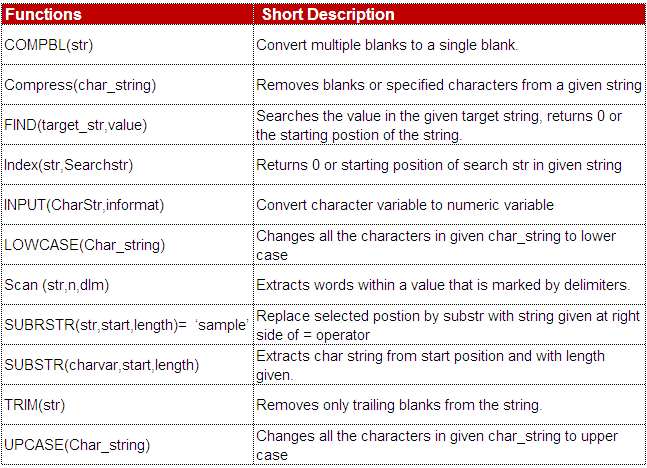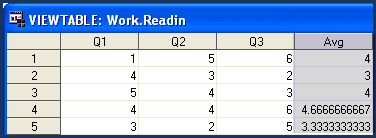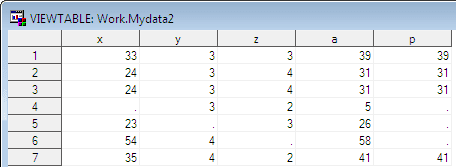TOP 50 SAS INTERVIEW QUESTIONS AND ANSWERS FOR 2020

This article includes most frequently requested top 50 SAS Interview questions and answers for 2020 which would help you to crack SAS Interview with confidence. It covers basic, intermediate and advanced concepts of SAS which outlines topics on reading data into SAS, data manipulation, reporting, SQL queries and SAS Macros. It includes questions ranging from simple theoretical concepts to tricky interview questions which are generally asked in freshers and experienced SAS programmers’ interview.
50 BEST SAS INTERVIEW QUESTIONS AND ANSWERS FOR 2020

1. Distinguish between INPUT and INFILE
The INFILE statement is used to identify an external file while the INPUT statment is used to describe you’re variables.
FILENAME TEST 'C:\DEEP\File1.xls'; DATA READIN; INFILE TEST; LENGTH NAME $25; INPUT ID NAME$ SEX; RUN;
Note : The variable name, followed by $ (dollar sign), idenfities the variable type as character. In the example shown above, ID and SEX are numeric variables and Name a character variable.
2. Distinguish between Informat and Format
Informats read the data while Formats write the data. Informat – To tell SAS that a number should be read in a particular format. For example: the informat mmddyy6. tells SAS to read the number121713as the date December 17, 2013. Format – To tell SAS how to print the variables.
3. Distinguish between Missover and Truncover
Missover -When the MISSOVER option is used on the INFILE statement, the INPUT statement does not jump to the next line when reading a short line. Instead, MISSOVER setsvariables to missing. Truncover – It assigns the raw data value to the variable even if the value is shorter then the length that is expected by the INPUT statement. The following is an example of an external file that contains data:
1 22 333 4444
This DATA step uses the numeric informat 4. to read a single field in each record of raw data and to assign values to the variable ID.
data readin; infile 'external-file' missover; input ID4.; run; proc print data=readin; run;
The output is shown below :
Obs ID 1 . 2 . 3 . 4 4444
Truncover
data readin; infile 'external-file' truncover; input ID4.; run; proc print data=readin; run;
The output is shown below :
Obs ID 1 1 2 22 3 333 4 4444
4. Purpose of double trailing@@ in Input Statement ?
The double trailing sign (@@)tells SAS rather then advancing to a new record, hold the current input record for the execution of the next INPUT statement.
DATA Readin; Input Name $ Score @@; cards; Sam 25 David 30 Ram 35 Deeps 20 Daniel 47 Pars 84 ; RUN;
The output is shown below :
 |
| Double Trailing |
5. How to include or exclude specific variables in a data set?
– DROP, KEEP Statements and Data set Options
DROP, KEEP Statement
The DROP statement specifies the names of the variables that you want to remove from the data set.
data readin1; set readin; drop score; run;
The KEEP statement specifies the names of the variables that you want to retain from the data set.
data readin1; set readin; keep var1; run;
DROP, KEEP Data set Options
The main difference between DROP/ KEEP statement and DROP=/ KEEP=data set option is that you can not use DROP/KEEP statement in procedures.
data readin1 (drop=score); set readin; run; data readin1 (keep=var1); set readin; run;
6. How to print observations 5 through 10 from a data set?
The FIRSTOBS= and OBS=data set options would tell SAS to print observations 5 through 10 from the data set READIN.
proc print data = readin (firstobs=5 obs=10); run;
7.What are the default statistics that PROC MEANS produce?
PROC MEANS produce the “default” statistics of N, MIN, MAX, MEAN and STD DEV.
8. Name and describe functions that you have used for data cleaning?
 |
| SAS Character Functions |
9.Difference between FUNCTION and PROC
Example : MEAN function and PROC MEANS
The MEAN function is an average of the value of several variables in one observation.
The average that is calculated using PROC MEANS is the sum of all of the values of a variable divided by the number of observations in the variable.
In other words,The MEAN function will sum across the row and a procedure will SUM down a column.
MEAN Function
AVG=MEAN (of Q1 - Q3);
See the output below :
 |
| MEAN Function Output |
PROC MEANS
PROC MEANS DATA=READIN MEAN; RUN;
The output is shown below :
 |
| PROC MEANS Output |
10. Differences between WHERE and IF statement?
For detailed explanation,
- WHERE statement can be used in procedures to subset data while IF statement cannot be used in procedures.
- WHERE can be used as a data set option while IF cannot be used as a data set option.
- WHERE statement is more efficient then IF statement. It tells SAS not to read all observations from the data set
- WHERE statement can be used to search for all similar character values that sound alike while IF statement cannot be used.
- WHERE statement can not be used when reading data using INPUT statement whereas IF statement can be used.
- Multiple IF statements can be used to execute multiple conditional statements
- When it is required to use newly created variables, useIF statement as it doesn’t require variables to exist in the READIN data set
11.What is Program Data Vector (PDV)?
PDV is a logical area in the memory.
How PDV is created?
SAS creates a dataset one observation at a time.Input buffer is created at the time of compilation, for holding a record from external file.PDV is created followed by the creation of input buffer.SAS builds dataset in the PDV area of memory.
12. What is DATA _NULL_?
The DATA _NULL_ is mainly used to create macro variables. It can also be used to write output without creating a dataset.The idea of “null” here is that we have a data step that actually doesn’t create a data set.
13. What is the difference between ‘+’ operator and SUM function?
SUM function returns the sum of non-missing arguments whereas “+” operator returns a missing value if any of the arguments are missing.
Suppose we have a data set containing three variables – X, Y and Z. They all have missing values. We wish to compute sum of all the variables.
data mydata2; set mydata; a=sum(x,y,z); p=x+y+z; run;
The output is shown in the image below :
 |
| SAS : SUM Function vsPlus Operator |
In the output, value of p is missing for 4th, 5th and 6th observations.
14. How to identify and remove unique and duplicate values?
1. Use PROC SORT with NODUPKEY and NODUP Options.
2. Use First. and Last. Variables
The detailed explanation is shown below :
SAMPLE DATA SET
| ID | Name | Score |
|---|---|---|
| 1 | David | 45 |
| 1 | David | 74 |
| 2 | Sam | 45 |
| 2 | Ram | 54 |
| 3 | Bane | 87 |
| 3 | Mary | 92 |
| 3 | Bane | 87 |
| 4 | Dane | 23 |
| 5 | Jenny | 87 |
| 5 | Ken | 87 |
| 6 | Simran | 63 |
| 8 | Priya | 72 |
Create this data set in SAS
data readin; input ID Name $ Score; cards; 1 David 45 1 David 74 2 Sam 45 2 Ram 54 3 Bane 87 3 Mary 92 3 Bane 87 4 Dane 23 5 Jenny 87 5 Ken 87 6 Simran 63 8 Priya 72; run;
There are several ways to identify and remove unique and duplicate values:
PROC SORT
In PROC SORT, they’re are two options by which we can remove duplicates.
1. NODUPKEY Option 2. NODUP Option
The NODUPKEY option removes duplicate observations where value of a variable listed in BY statement is repeated while NODUP option removes duplicate observations where values in all the variables are repeated (identical observations).
PROC SORT DATA=readin NODUPKEY; BY ID; RUN;
PROC SORT DATA=readin NODUP; BY ID; RUN;
The output is shown below :
 |
| SAS : NODUPKEY vs NODUP |
The NODUPKEY has deleted 5 observations with duplicate values whereas NODUP has not deleted any observations.
Why no value has been deleted when NODUP option is used?
Although ID 3 has two identical records (See observation 5 and 7), NODUP option has not removed them. It is because they are not next to one another in the dataset and SAS only looks at one record back.
To fix this issue, sort on all the variables in the dataset READIN.
To sort by all the variables without having to list them all in the program, you can use the keywork ‘_ALL_’in the BY statement (see below).
PROC SORT DATA=readin NODUP; BY _all_; RUN;
The output is shown below :
 |
| SAS NODUP Output |
15. Difference between NODUP and NODUPKEY Options?
The NODUPKEY option removes duplicate observations where value of a variable listed in BY statement is repeated while NODUP option removes duplicate observations where values in all the variables are repeated (identical observations).
See the detailed explanation for this question above (Q14).
16. What are _numeric_ and _character_ and what do they do?
1. _NUMERIC_ specifies all numeric variables that are already defined in the current DATA step.
2. _CHARACTER_ specifies all character variables that are currently defined in the current DATA step.
3. _ALL_ specifies all variables that are currently defined in the current DATA step.
Example : To include all the numeric variables in PROC MEANS
proc means; var _numeric_; run;
17. How to sort in descending order?
Use DESCENDING keyword in PROC SORT code. The example below shows the use of the descending keyword.
PROC SORT DATA=auto; BY DESCENDING engine ; RUN ;
18. Under what circumstances would you code a SELECT construct instead of IF statements?
When you have a long series of mutually exclusive conditions and the comparison is numeric, using a SELECT group is slightly more efficient then using IF-THEN or IF-THEN-ELSE statements because CPU time is reduced.
The syntax for SELECT WHEN is as follows :
SELECT (condition);
WHEN (1) x=x;
WHEN (2) x=x*2;
OTHERWISE x=x-1;
END;
Example :
SELECT (str);
WHEN (‘Sun’) wage=wage*1.5;
WHEN (‘Sat’) wage=wage*1.3;
OTHERWISE DO;
wage=wage+1;
bonus=0;
END;
END;
19. How to convert a numeric variable to a character variable?
You must create a differently-named variable using the PUT function.
The example below shows the use of the PUT function.
charvar=put(numvar, 7.) ;
20. How to convert a character variable to a numeric variable?
You must create a differently-named variable using theINPUTfunction.
The example below shows the use of the INPUT function.
numvar=input(charvar,4.0);
21. What’s the difference between VAR A1 – A3 and VAR A1 — A3?
Single Dash :It is used to specify consecutively numbered variables. A1-A3 implies A1, A2 and A3.
Double-dash :It is used to specify variables based on the order of the variables as they appear in the file,regardless of the name of the variable. A1–A3 implies all the variables from A1 to A3 in the order they appear in the data set.
Example :The order of variables in a data set : ID Name A1 A2 C1 A3
So using A1-A3 would returnA1 A2 A3. A1–A3 would returnA1 A2 C1 A3.
22. Difference between PROC MEANS and PROC SUMMARY?
1. Proc MEANS by default produces printed output in the OUTPUT window whereas Proc SUMMARY does not. Inclusion of the PRINT option on the Proc SUMMARY statement will output results to the output window.
2. Omitting the var statement in PROC MEANS analyses all the numeric variables whereas Omitting the variable statement in PROC SUMMARY produces a simple count of observation.
How to produce output in the OUTPUT window using PROC SUMMARY?
Use PRINT option.
proc summary data=retail print; class services; var investment; run;
23. Can PROC MEANS analyze ONLY the character variables?
No, Proc Means requires at least one numeric variable.
24. How SUBSTR function works?
The SUBSTR function is used to extract substring from a character variable.
The SUBSTR function has three arguments:
SUBSTR ( character variable, starting point to begin reading the variable, numberof characters to read from the starting point)
There are two basic applications of the SUBSTR function:
RIGHT SIDE APPLICATION
data _null_ ; phone='(312) 555-1212' ; area_cd=substr(phone, 2, 3) ; put area_cd=; run;
Result : In the log window, it writes area_cd=312 .
LEFT SIDE APPLICATION
It is used to change just a few characters of a variable. data _null_ ; phone='(312) 555-1212′ ; substr(phone, 2, 3)=’773′ ; put phone=; run ; Result : The variable PHONE has been changed from(312) 555-1212 to (773) 555-1212.
25. Difference between CEIL and FLOOR functions?
The ceil function returns the smallest integer greater then/equal to the argument whereas the floor returns the greatest integer less then/equal to the argument.
For example : ceil(4.4) returns 5 whereas floor(4.4) returns 4.
26. Difference between SET and MERGE?
SET concatenates the data sets where as MERGE matches the observations of the data sets.
27. How to do Matched Merge and output only consisting of observations from both files?
Use IN=variable in MERGE statements. It is used for matched merge to track and select which observations in the data set from the merge statement will go to a new data set.
data readin;
merge file1(in=infile1) file2(in=infile2);
by id;
if infile1=infile2;
run;
28. How to do Matched Merge and output consisting of observations in file1 but not in file2, or in file2 but not in file1?
data readin; merge file1(in=infile1)file2(in=infile2); by id; if infile1 ne infile2; run;
29. How to do Matched Merge and output consisting of observations from only file1?
data readin;
merge file1(in=infile1)file2(in=infile2);
by id;
if infile1;
run;
30. How do I create a data set with observations=100, mean 0 and standard deviation 1?
data readin;
do i=1 to 100;
temp=0 + rannor(1) * 1;
output;
end;
run;
proc means data=readin mean stddev;
var temp;
run;
31. How to label values and use it in PROC FREQ?
Use PROC FORMAT to set up a format.
proc format; value score 0 - 100=‘100-‘ 101 - 200=‘101+’ other=‘others’ ; proc freq data=readin; tables outdata; format outdatascore. ; run;
32. How to use arrays to recode set of variables?
Recode the set of questions: Q1,Q2,Q3…Q20 in the same way: if the variable has a value of 6 recode it to SAS missing.
data readin; set outdata; array Q(20) Q1-Q20; do i=1 to 20; if Q(i)=6 than Q(i)=.; end; run;
33. How to use arrays to recode all the numeric variables?
Use _numeric_ and dim functions in array.
data readin; set outdata; array Q(*) _numeric_; do i=1 to dim(Q); if Q(i)=6 than Q(i)=.; end; run;
Note : DIM returns a total count of the number of elements in array dimension Q.
34. How to calculate mean for a variable by group?
Suppose Q1 is a numeric variable and Age a grouping variable. You wish to compute mean for Q1 by Age.
PROC MEANS DATA=READIN; VAR Q1; CLASS AGE; RUN;
35. How to generate cross tabulation?
Use PROC FREQ code.
PROC FREQ DATA=auto; TABLES A*B ; RUN;
SAS will produce table of A by B.
36. How to generate detailed summary statistics?
Use PROC UNIVARIATE code.
PROC UNIVARIATE DATA=READIN; CLASS Age; VAR Q1; RUN;
Note : Q1 is a numeric variable and Age a grouping variable.
37. How to count missing values for numeric variables?
Use PROC MEANS with NMISSoption.
38. How to count missing values for all variables?
proc format; value $missfmt ' '='Missing' other='Not Missing'; value missfmt .='Missing' other='Not Missing'; run;
proc freq data=one; format _CHAR_ $missfmt.; tables _CHAR_ / missing missprint nocum nopercent; format _NUMERIC_ missfmt.; tables _NUMERIC_ / missing missprint nocum nopercent; run;
39. Describe the ways in which you can create macro variables
There are 5 ways to create macro variables:
- %Let
- Iterative %DO statement
- Call Symput
- Proc SQl into clause
- Macro Parameters.
40. Use of CALL SYMPUT
CALL SYMPUT puts the value from a dataset into a macro variable.
proc means data=test;
var x;
output out=testmean mean=xbar;
run;
data _null_;
set testmean;
call symput("xbarmac",xbar);
run;
%put mean of x is &xbarmac;
41. What are SYMGET and SYMPUT?
SYMPUT puts the value from a dataset into a macro variable whereas
SYMGET gets the value from the macro variable to the dataset.
42. Which date function advances a date, time or datetime value by a given interval?
INTNX function advances a date, time, or datetime value by a given interval, and returns a date, time, or datetime value. Ex: INTNX(interval,start-from,number-of-increments,alignment).
43. How to count the number of intervals between two given SAS dates?
INTCK(interval,start-of-period,end-of-period) is an interval function that counts the number of intervals between two give SAS dates, Time and/or datetime.
44. Difference between SCAN and SUBSTR?
SCAN extracts words within a value that is marked by delimiters. SUBSTR extracts a portion of the value by stating the specific location. It is best used when we know the exact position of the sub string to extract from a character value.
45. The following data step executes:
Data strings; Text1=“MICKEY MOUSE & DONALD DUCK”; Text=scan(text1,2,’&’); Run;
What will the value of the variable Text be?
* DONALD DUCK [(Leading blanks are displayed using an asterisk *]
46. For what purpose would you use the RETAIN statement?
A RETAIN statement tells SAS not to set variables to missing when going from the current iteration of the DATA step to the next. Instead, SAS retains the values.
47. When grouping is in affect, can the WHERE clause be used in PROC SQL to subset data?
No. In order to subset data when grouping is in affect, the HAVING clause must be used. The variable specified in having clause must contain summary statistics.
48. How to use IF THEN ELSE in PROC SQL?
PROC SQL; SELECT WEIGHT, CASE WHEN WEIGHT BETWEEN 0 AND 50 THEN ’LOW’ WHEN WEIGHT BETWEEN 51 AND 70 THEN ’MEDIUM’ WHEN WEIGHT BETWEEN 71 AND 100 THEN ’HIGH’ ELSE ’VERY HIGH’ END AS NEWWEIGHT FROM HEALTH; QUIT;
49. How to remove duplicates using PROC SQL?
Proc SQL noprint;
Create Table inter.Merged1 as
Select distinct * from inter.readin ;
Quit;
50. How to count unique values by a grouping variable?
You can use PROC SQL with COUNT(DISTINCT variable_name) to determine the number of unique values for a column.
51. Difference between %EVAL and %SYSEVALF
%EVAL cannot perform arithmetic calculations with operands that have the floating point values. It is when the %SYSEVALF function comes into picture.
%let last=%eval (4.5+3.2); %let last2=%sysevalf(4.5+3.2); %put &last2;
52. How to debug SAS Macros
There are some system options that can be used to debug SAS Macros:
MPRINT, MLOGIC, SYMBOLGEN.
53. How to save log in an external file
Use PROC PRINTTO
proc printto log="C:\Users\Deepanshu\Downloads\LOG2.txt" new; run;
54. How Data Step Merge and PROC SQL handle many-to-many relationship?
Data Step MERGE does not create a cartesian product in case of a many-to-many relationship. Whereas, Proc SQL produces a cartesian product.
55. What is the use of ‘BY statement’ in Data Step Merge?
Without ‘BY’ statement, Data Step Merge performs merging without matching. In other words, the records are combined based on they’re relative position in the data set. The second data set gets placed to the “right” of the first data set (no matching based on the unique identifier – if data is not sorted based on unique identifier, wrong records can be merged).
When you use ‘BY’ statement, it matches observations according to the values of the BY variables that you specify.
66. Which is more faster- Data Step / Proc SQL
The SQL procedure performed better with the smaller datasets (less then approx. 100 MB) whereas the data step performed better with the larger ones (more then approx. 100 MB).
It is because the DATA step handles each record sequentially so it never uses a lot of memory, however, it takes time to process one at a time. So with a smaller dataset, the DATA step is going to take more time sending each record through.
With the SQL procedure, everything is loaded up into memory at once. By doing this, the SQL procedure can process small datasets rather quickly since everything is available in memory. Conversely, when you move to larger datasets, you’re memory can get bogged down which than leads to the SQL procedure being a little bit slower compared to the DATA step which will never take up too much memory space.
If you need to connect directly to a database and pull tables from they're, than use PROC SQL.


